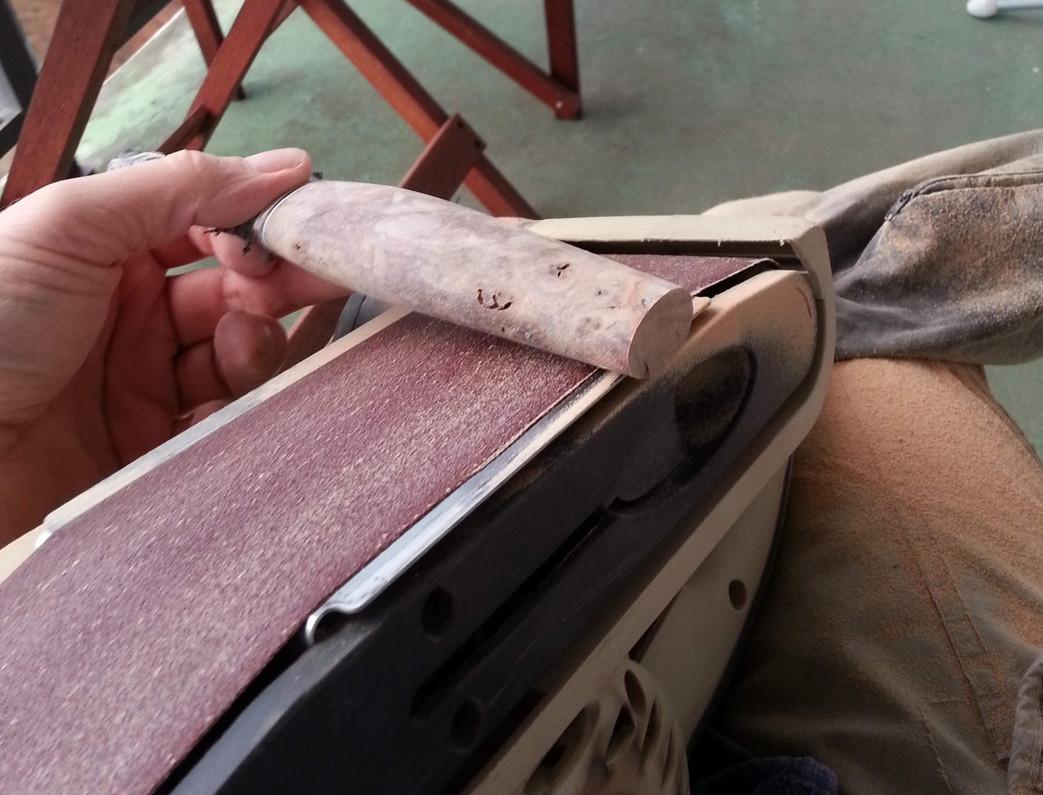How To Get Into Knife Making?
How to get into knife making?

Knife making is something that can look a bit daunting before you start. You may not be across what tools and equipment you need, or not be across all the steps involved. In this article we will break it down into a couple of different options to make it easier to jump in and have a go.
“Knife making” can mean different things to different people. To me it means making a knife from a blade and handle materials. So you can start by making your own handle on a ready-made blade, or as complicated as forging your own blade. In between you have “stock removal”, meaning you start with a piece of steel and grind it to shape.
Whether you decide to start with kit knife making, stock removal or forging is usually decided by how much time and tools you have available, as well as the area available to work in. Many stay with kit knife making, enjoying the handle and leather work. Others move into blade making over time.
Kit Knifemaking:
- Select a ready-made blade in a style you like
- Personalise with handle materials such as wood, antler or acrylics
- Design your knife and put it together
- Few tools are required, you are basically doing a woodworking project. Cordless drill, a couple of clamps and files, a belt sander and you are ready to go. A Dremel is useful but not required. Can be done on a balcony or in a small back yard with little impact to neighbours.
Stock Removal:
- You will make both the blade and the handle
- Select a steel and design your blade shape
- Grind out the shape and bevels with an angle grinder and/or files
- Heat treat at home or send out for hardening
- Grind bevels to sharp and hand sand blade to the desired finish
- Create handle (back on Kit Knifemaking)
- Few
tools are required: Hand files, clamps, hacksaw or angle grinder would be
minimum, up to a
“proper” knife grinder ($1000-$300) after a while when hand filing loses its charm. Can be done in a basement or garage but generally requires an outdoors area due to noise and dust.
Blade Forging:
- Forge your blade from a piece of steel
- Grind to final shape, file in bevels and heat treat (back on Stock Removal)
- Create handle (back on Kit Knifemaking)
- Requires more tools such as forge, anvil, hammers and tongs and generally done outdoors with a fair amount of noise.

Kit knifemaking has the advantage of being quick, so you get to build something in a couple of afternoons. Meaning you get to try out different blade types, handle materials and processes such as making one full tang chef knife and one stick tang camping knife in a fairly short amount of time. Tools and processes involved are mostly limited to wood and leather working, allowing a high degree of flexibility and creative outlet involving materials and processes.
Wanting to also make your own blade takes you into metalworking, requiring different tools and often a bit of studying to be successful. Heat treatment and blade geometry requires maybe more of an engineering mindset than an artist’s, focusing on not only making it look right but also function correctly. Achieving at least a basic understanding of metallurgy and taking a piece of steel to a working blade can be a very rewarding experience. Time spent per knife increases significantly, often five or more afternoons are required for all the steps involved even when going with a basic handle design.
Being the blacksmith: There is something powerful in being able to shape a piece of steel to your will with a hammer and fire. Taking an old rusty piece of steel and bringing it back to life in a new form, or starting with a small piece of a known blade steel and shaping it to your design can be very satisfying. Most of us amateurs in forging still need to grind the blade to final shape, forging is more a precursor to stock removal, than instead of. So we forge the blade as close to shape as we can, then move onto stock removal to grind to final shape and grind bevels.

Hopefully that gave an overview of the three main branches of knife making, and an idea of where to start based on your interest, tools and time.
So in summary, you can start with a few hand tools and build from there:
- cordless drill
- a few clamps
- couple of files and some sand paper
- belt sander (not required but makes shaping the handle much easier)
- dremel (not required but very useful)
- angle grinder/hacksaw/coarse metal files if wanting to also make the blade
Joining a group of others already involved in knife making will help give an idea of what is involved before you start, and help with inspiration and feedback during your project. As well as offering the opportunity to get to know other makers in your area, so joining for instance the group Australian Beginner Knife making on facebook is also a good step towards getting involved.
List of all blog posts: https://creativeman.com.au/blog/?limit=100
Recent Posts
-
Why Bed The Tang In Epoxy - Then Knock it OFF Again.
What is "Bedding the tang"? Bedding the tang means gluing a stick-tang blade into the handle block i …21st Mar 2025 -
Marble Leather - How to Dip Dye Veg Tanned Leather
This was my first experiment with hydrodipping or dip dying leather, and it came out pretty cool! I …14th Mar 2025 -
Make Burl Wood POP!
Staining wood with leather dye. or "How to make burl wood really pop". This technique really only wo …8th Mar 2025




